python中文件的读取与写入以及os模
发布时间:2019-06-24 15:40:14编辑:auto阅读(2153)
1.文件读取的三部曲:打开 ---> 操作 ----> 关闭
r(默认参数):
-只能读,不能写
-读取文件不存在 会报错
FileNotFoundError: [Errno 2] No such file or directory: '/tmp/westos'
w(写)
-write only
-文件不存在的时候,会自动创建新的文件
-文件存在的时候,会清空文件内容并写入新的内容
a(追加):
-write only
-写:不会清空文件的内容,会在文件末尾追加
-写:文件不存在,不会报错,会创建新的文件并写入内容
r+
-r/w
-文件不存在,报错
-默认情况下,从文件指针所在位置开始写入
w+
-r/w
-文件不存在,不报错
-会清空文件内容
a+
-r/w
-文件不存在,不报错
-不会清空文件,在末尾追加 f = open('/tmp/westos3','w+') /tmp/westos3文件不存在,自动创建了文件并写入了信息
print(f)
print(f.tell()) 打印文件指针的位置 此时为0
f.write('111') 写入‘111’
print(f.tell()) 再次打印指针位置可以看到指针为3
f.close() 关闭文件
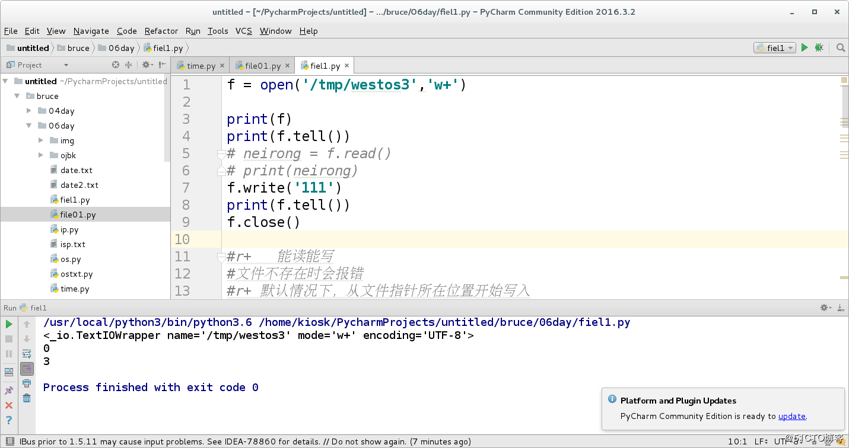
f = open('/tmp/redhat','a+') 不会清空文件,在末尾追加
print(f) 文件指针的位置开始为0
print(f.tell())
f.write('111') 文件执行5此后指针在15
print(f.tell())
f.close() 关闭文件
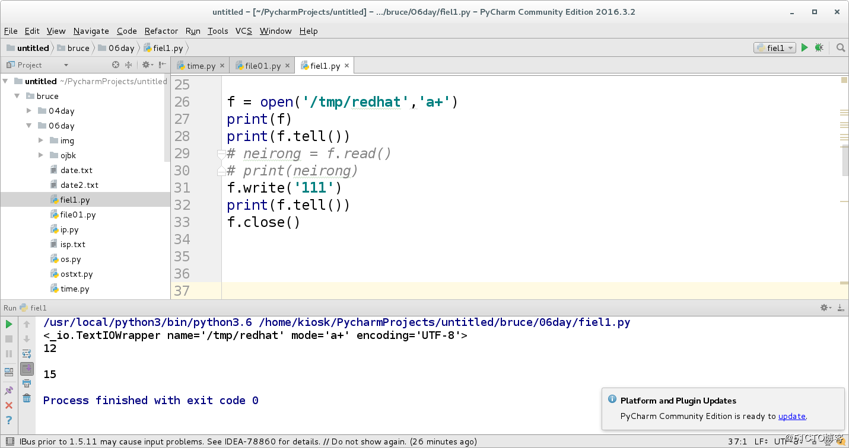
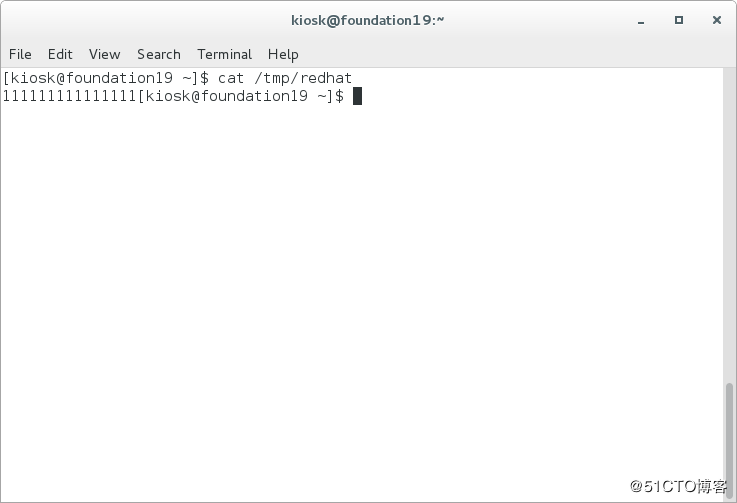
2.文件的操作
#1.打开文件
f = open('/tmp/westos','r')
#2.操作
print(f)
#读文件
#content = f.read()
#print(content)
#写文件
#告诉当前的文件指针所在的位置
#print(f.tell())
#f.write('westos')
#print(f.tell())
#f.write('redhat')
#print(f.tell())
#判断文件对象拥有的权限
print(f.readable()) 是否可读
print(f.writable()) 是否可写
print(f.tell()) 文件的指针
content = f.read() 把读取的内容指向content
print(content)
print(f.tell())
content1 = f.read()
print(content1)
#print(content)
3.关闭文件
f.close()
2.如果读取是 图片 音频 视频(非纯文本文件)
需要通过二进制的方式读取和写入
-读取纯文本
r r+ w w+ a a+ == rt rt+ wt wt+ at at+
-读取二进制文件
rb rb+ wb wb+ ab ab+
#读取二进制文件内容
f1 = open('hello.png',mode='rb') 只读模式
content = f1.read()
f1.close()
#写入要复制的文件的内容
f2 = open('lucky.jpg',mode='wb') 写入模式
f2.write(content)
f2.close()
复制hello.png并创建新的lucky.jpg 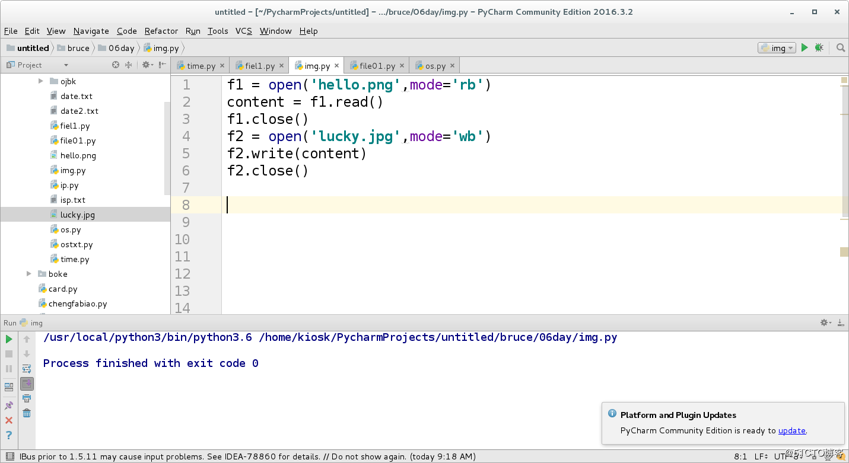
3.
默认情况下读取文件的内容 小的文件:直接用read读取即可
如果是一个大文件(文件大小>=内存大小) readline()
f = open('/tmp/passwd','rb+')
#按行读取
#print(f.readline())
#按字节读取
#print(f.read(3))
#读取文件内容,并返回一个列表,列表元素分别为文件的行内容
print(f.readlines())
#指针的移动
#print(f.tell())
#print(f.read(10))
#print(f.tell())
#f.seek(2,2)
seek:指针移动
第一个参数:偏移量 >0:代表向后移动 <0 代表向前移动
第二个参数:
0:移动指针到文件开头
1:当前位置
2:移动指针到末尾
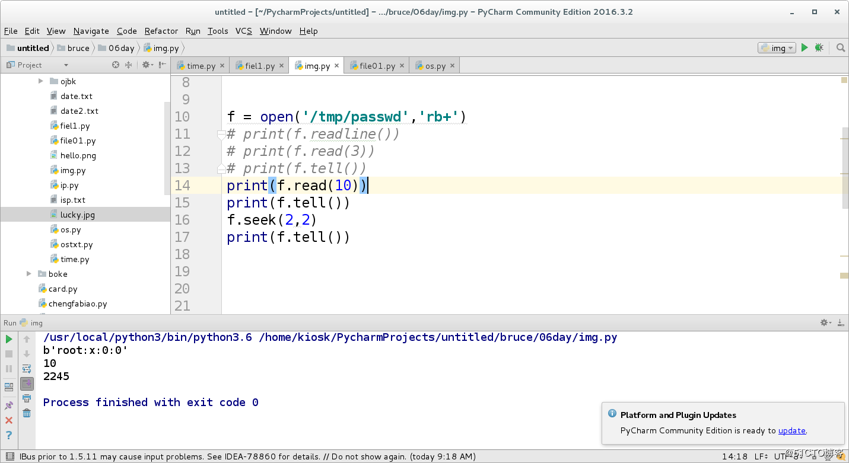
#读取/tmp/passwd内容,返回一个列表,去掉后面的\n
f = open('/tmp/passwd')
print(list(map(lambda x:x.strip(),f.readlines())))
print([line.strip() for line in f.readlines()])
f.close()
#创建文件data.txt 文件共100000行,
#每行存放以一个1~100之间的整数
import random
f = open('data.txt','a+')
for i in range(100000):
f.write(str(random.randint(1,100)) + '\n')
#移动文件指针
f.seek(0,0)
print(f.read())
f.close()
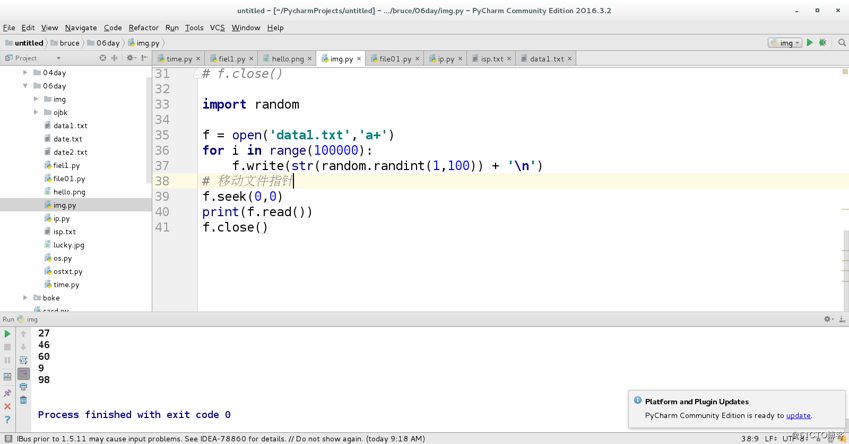
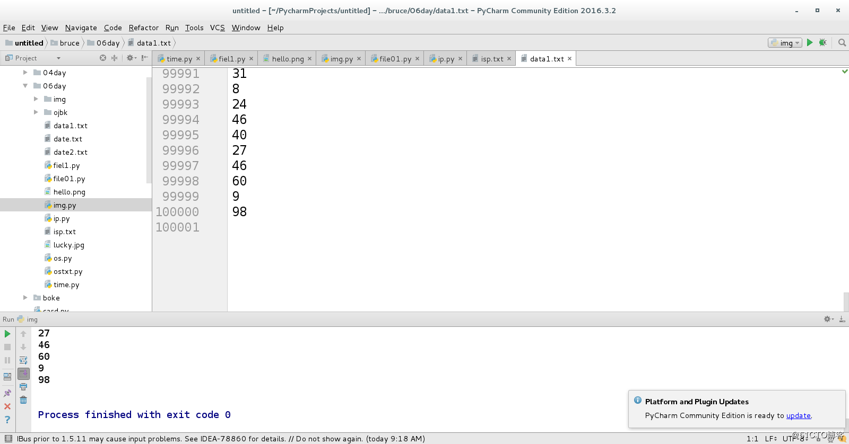
4.
上下文管理器:打开文件,执行完with语句内容之后,自动关闭文件
with open('/tmp/passwd') as f:
print(f.read())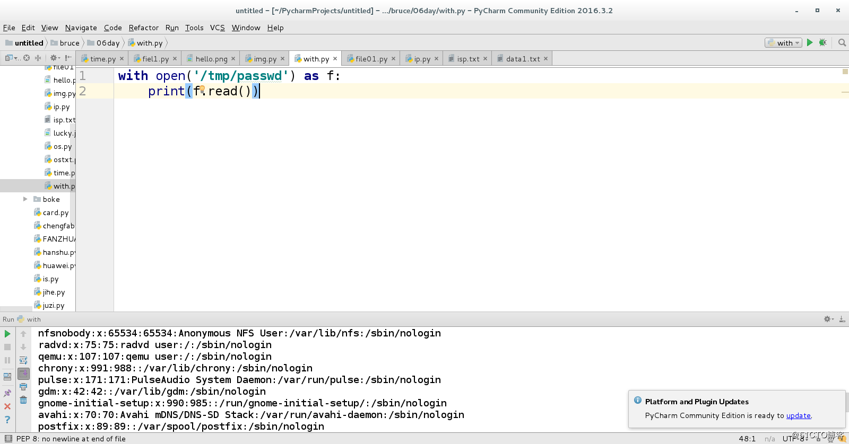
#将第一个文件的内容写道第二个文件中
with open('date.txt') as f1,open('data3.txt','w+') as f2:
f2.write(f1.read())
f2.seek(0,0)
print(f2.read())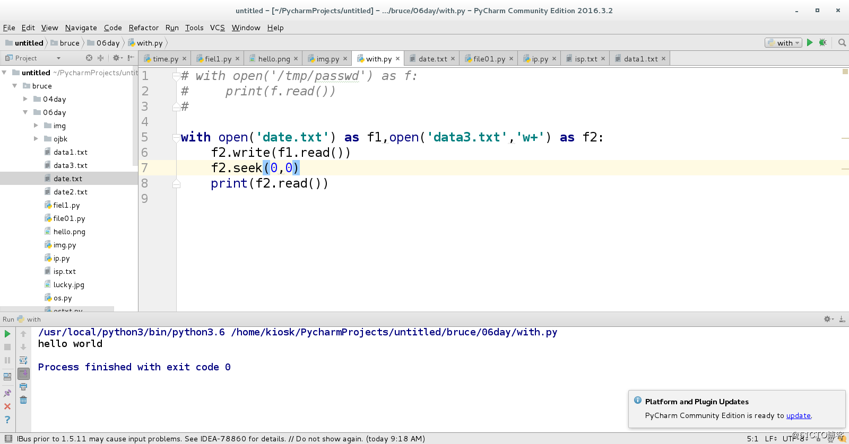
练习:
生成100个MAC地址并写入文件中,MAC地址前6位(16进制)为01-AF-3B
01-AF-3B-xx-xx-xx
-xx
01-AF-3B-xx
-xx
01-AF-3B-xx-xx
-xx
01-AF-3B-xx-xx-xx
import string
import random
def create_mac():
MAC = '01-AF-3B'
#生成16进制的数
hex_num = string.hexdigits
for i in range(3):
从16进制字符串中随即选出两个数字来
#返回值是列表
n = random.sample(hex_num, 2)
#拼接列表中的内容,将小写的字母转换成大写的字母
sn = '-' + ''.join(n).upper()
MAC += sn
return MAC#主函数:随即生成100个MAC地址
def main():
#以写的方式打开一个文件
with open('mac.txt', 'w') as f:
for i in range(100):
mac = create_mac()
print(mac)
#每生成一个MAC地址,存入文件
f.write(mac + '\n')
main()
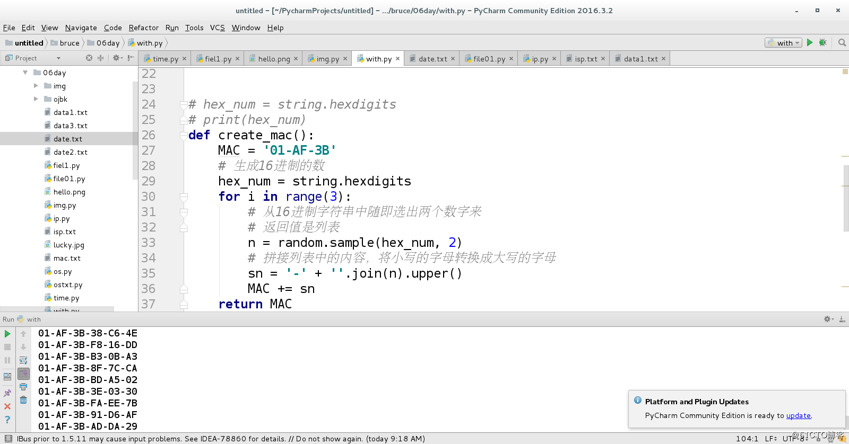
#1. 生成一个大文件ips.txt,要求1200行,每行随机为172.25.254.0/24段的ip;
#2. 读取ips.txt文件统计这个文件中ip出现频率排前10的ip;
import random
def create_ip_file(filename):
ips = ['172.25.254.' + str(i) for i in range(0,255)]
print(ips)
with open(filename,'a+') as f:
for count in range(1200):
f.write(random.sample(ips,1)[0] + '\n')
#create_ip_file('ips.txt')
def sorted_ip(filename,count=10):
ips_dict = dict()
with open(filename) as f:
for ip in f:
if ip in ips_dict:
ips_dict[ip] += 1
else:
ips_dict[ip] = 1
sorted_ip = sorted(ips_dict.items(),
key= lambda x:x[1],reverse=True)[:count]
return sorted_ip
print(sorted_ip('ips.txt',20))
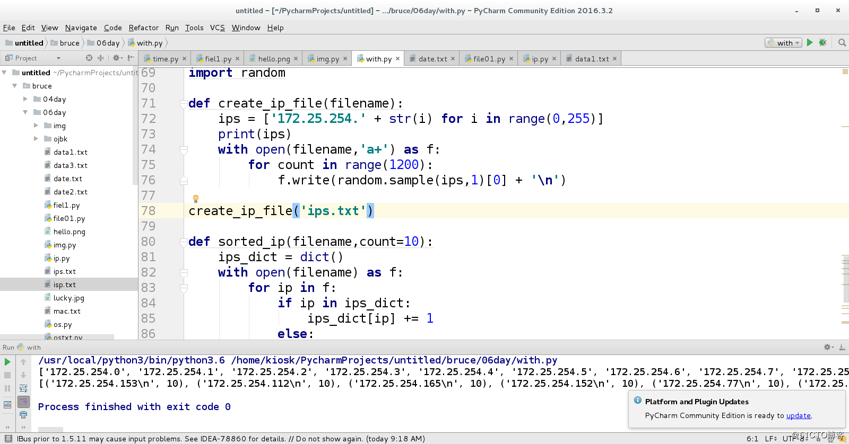
import random
f = open('/tmp/isp1.txt','w+') #以w+模式打开创建文件
for i in range(1200):
ip = '172.25.254.'
num = random.randint(0,255) #拼接172.25.254.(num)
f.write(ip+str(num)+'\n')
f.seek(0,0) #从指针最开始读取
s = {}
for i in f.readlines():
if i not in s :
s[i] = 1
else:
s[i] += 1
list = list(s.items())
list1 = sorted(list,key=lambda x:x[1],reverse=True)
print(list1[0:10])
f.close()#关闭文件
二。os模块
import os
1.返回操作系统类型 值为:posix 是linux操作系统
值为nt 是windows操作系统
print(os.name)
print('Linux' if os.name == 'posix' else 'Windows')
2.操作系统的详细信息
info = os.uname()
print(info)
print(info.sysname)
print(info.nodename)
3.系统的环境变量
print(os.environ)
通过key值获取环境变量对应的value值
print(os.environ.get('PATH'))
4.判断是否是绝对路径
print(os.path.isabs('/tmp/ffff'))
print(os.path.isabs('hello.jog'))
5.生成绝对路径
print(os.path.abspath('hello.png'))
print(os.path.join(os.path.abspath('.'),'hello.jpg'))
print(os.path.join('/home/kiosk','hello.jpg'))
6.获取目录或文件名
filename = '/home/dd/20190523/day06/hello.jpg'
print(os.path.basename(filename))
print(os.path.dirname(filename))
7.创建目录
mkdir mkdir -p
os.mkdir('img')
os.makedirs('img/file1/file2')
不能传归删除目录
os.rmdir('img')
8.创建文件 删除文件
os.mknod('00_ok.txt')
os.remove('00_ok.txt')
9.文件重命名
os.rename('data.txt','data1.txt
10.判断文件或目录是否存在
print(os.path.exists('ips.txtyyyy'))
11.分离后缀名和文件名
print(os.path.splitext('hello.jpg'))
12.将目录名和文件名分离
print(os.path.split('/tmp/hello/hello.jpg'))
上一篇: Python类与方法的私有化
下一篇: nginx+uwsgi+python+f
- openvpn linux客户端使用
50956
- H3C基本命令大全
50338
- openvpn windows客户端使用
40955
- H3C IRF原理及 配置
37822
- Python exit()函数
32287
- openvpn mac客户端使用
29177
- python全系列官方中文文档
28064
- python 获取网卡实时流量
22894
- 1.常用turtle功能函数
22856
- python 获取Linux和Windows硬件信息
21188
- Python搭建一个RAG系统(分片/检索/召回/重排序/生成)
1046°
- Browser-use:智能浏览器自动化(Web-Agent)
1725°
- 使用 LangChain 实现本地 Agent
1407°
- 使用 LangChain 构建本地 RAG 应用
1344°
- 使用LLaMA-Factory微调大模型的function calling能力
1604°
- 复现一个简单Agent系统
1436°
- LLaMA Factory-Lora微调实现声控语音多轮问答对话-1
2091°
- LLaMA Factory微调后的模型合并导出和部署-4
3634°
- LLaMA Factory微调模型的各种参数怎么设置-3
3552°
- LLaMA Factory构建高质量数据集-2
2508°
- 姓名:Run
- 职业:谜
- 邮箱:383697894@qq.com
- 定位:上海 · 松江
